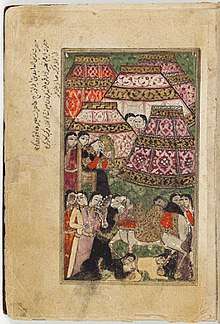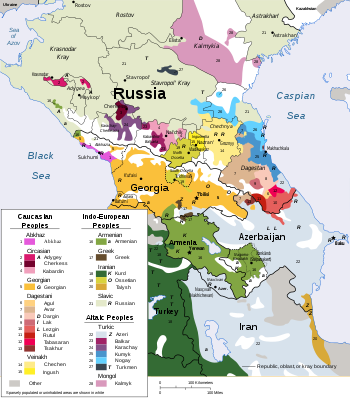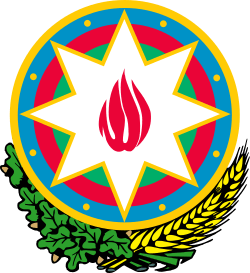Azerbaijani language
Azerbaijani (/ˌæzərbaɪˈdʒɑːni/) or Azeri (/æˈzɛəri, ɑː-, ə-/), also referred to as Azeri Turkic[7] or Azeri Turkish,[8][9] is a Turkic language spoken primarily by the Azerbaijani people, who live mainly in the Republic of Azerbaijan (former Soviet) where the North Azerbaijani variety is spoken, and in the Azerbaijan region of Iran, where the South Azerbaijani variety is spoken.[10] Although there is a very high degree of mutual intelligibility between both forms of Azerbaijani, there are some significant differences in phonology, lexicon, morphology, syntax and sources of loanwords.[2]
| Azerbaijani | |
|---|---|
| Azərbaycan dili, آذربایجان دیلی, Азәрбајҹан дили[note 1] | |
| Pronunciation | [ɑːzæɾbɑjˈdʒɑn diˈli] |
| Native to | |
| Region | Azerbaijan (historic Azerbaijan) and Caucasus |
| Ethnicity | Azerbaijanis |
Native speakers | 23 million (2018)[1] |
Turkic
| |
Standard forms | Shirvani (In Azerbaijan Republic)
Tabrizi (In Iranian Azerbaijan region)
|
| Dialects | |
| |
| Official status | |
Official language in | Organisations:
|
| Regulated by |
|
| Language codes | |
| ISO 639-1 | az |
| ISO 639-2 | aze |
| ISO 639-3 | aze – inclusive codeIndividual codes: azj – North Azerbaijaniazb – South Azerbaijanislq – Salchuqqxq – Qashqai |
| Glottolog | mode1262 Modern Azeric[4]nort2697 North Azerbaijani[5]sout2697 South Azerbaijani[6] |
| Linguasphere | part of 44-AAB-a |
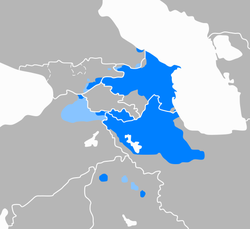 Location of Azerbaijani speakers in Transcaucasia regions where Azerbaijani is the language of the majority regions where Azerbaijani is the language of a significant minority | |
| Part of a series on |
| Azerbaijanis |
|---|
| Culture |
| Traditional areas of settlement |
| Diaspora |
| Religion |
|
| Language |
| Persecution |
|
|
North Azerbaijani has official status in the Republic of Azerbaijan and Dagestan (a federal subject of Russia) but South Azerbaijani does not have official status in Iran, where the majority of Azerbaijani people live. It is also spoken to lesser varying degrees in Azerbaijani communities of Georgia and Turkey and by diaspora communities, primarily in Europe and North America.
Both Azerbaijani varieties are members of the Oghuz branch of the Turkic languages. The standardized form of North Azerbaijani (spoken in the Republic of Azerbaijan and Russia) is based on the Shirvani dialect, while Iranian Azerbaijani uses the Tabrizi dialect as its prestige variety. Azerbaijani is closely related to Gagauz, Qashqai, Crimean Tatar, Turkish and Turkmen, sharing varying degrees of mutual intelligibility with each of those languages.[11] According to linguistic comparative studies, the closest relative of Azerbaijani is the Turkmen language.[12]
Etymology and background
Historically the language was referred by its native speakers as Türki[13] meaning "Turkic" or Azərbaycan türkcəsi meaning "Azerbaijani Turkic". Prior to the establishment of the Azerbaijan Democratic Republic, who adopted the name of "Azerbaijan" for political reasons in 1918, the name of "Azerbaijan" was exclusively used to identify the adjacent region of contemporary northwestern Iran.[14][15][16] After the establishment of the Azerbaijan SSR,[17] on the order of Soviet leader Stalin, the "name of the formal language" of the Azerbaijan SSR was "changed from Turkic to Azerbaijani".[17]
History and evolution
Azerbaijani evolved from the Eastern branch of Oghuz Turkic ("Western Turkic")[19] which spread to the Caucasus, in Eastern Europe,[20][21] and northern Iran, in Western Asia, during the medieval Turkic migrations.[22] Persian and Arabic influenced the language, but Arabic words were mainly transmitted through the intermediary of literary Persian.[23] Azerbaijani is, perhaps after Uzbek, the Turkic language upon which Persian and other Iranian languages have exerted the strongest impact—mainly in phonology, syntax, and vocabulary, less in morphology.[24]
The Turkic language of Azerbaijan gradually supplanted the Iranian languages in what is now northwestern Iran, and a variety of languages of the Caucasus and Iranian languages spoken in the Caucasus, particularly Udi and Old Azeri. By the beginning of the 16th century, it had become the dominant language of the region and the second most important language of Iran after Persian as it was a spoken language in the court of the Safavids, Afsharids and Qajars.
The historical development of Azerbaijani can be divided into two major periods: early (c. 16th to 18th century) and modern (18th century to present). Early Azerbaijani differs from its descendant in that it contained a much larger number of Persian, and Arabic loanwords, phrases and syntactic elements. Early writings in Azerbaijani also demonstrate linguistic interchangeability between Oghuz and Kypchak elements in many aspects (such as pronouns, case endings, participles, etc.). As Azerbaijani gradually moved from being merely a language of epic and lyric poetry to being also a language of journalism and scientific research, its literary version has become more or less unified and simplified with the loss of many archaic Turkic elements, stilted Persiansms and Ottomanisms, and other words, expressions, and rules that failed to gain popularity among the Azerbaijani masses.
Between c. 1900 and 1930, there were several competing approaches to the unification of the national language in what is now the Azerbaijan Republic, popularized by the scholars such as Hasan bey Zardabi and Mammad agha Shahtakhtinski. Despite major differences, they all aimed primarily at making it easy for semi-literate masses to read and understand literature. They all criticized the overuse of Persian, Arabic, and European loanwords in both colloquial and literary language and called for a simpler and more popular style.
The Russian conquest of Transcaucasia in the 19th century split the language community across two states; the Soviet Union promoted the development of the language, but set it back considerably with two successive script changes[25] – from the Persian to Latin and then to the Cyrillic script – while Iranian Azerbaijanis continued to use the Persian script as they always had but it faced a short period oppression under the rule of Reza Shah Pahlavi who made Persian the only official language of Iran. Despite the wide use of Azerbaijani in the Azerbaijan Soviet Socialist Republic, it became the official language of Azerbaijan only in 1956.[26] After independence, the Azerbaijan Republic decided to switch back to a modified Latin script.
Azerbaijani literature

The development of Azerbaijani literature is closely associated with Turkish, written in Perso-Arabic script. Examples of its detachment date to the 14th century or earlier.[27][28] Kadi Burhan al-Din, Hesenoghlu, and Imadaddin Nasimi helped to establish Azerbaiijani as a literary language in the 14th century through poetry and other works.[28] The ruler and poet Ismail I wrote under the pen name Khatā'ī (which means "sinner" in Persian) during the fifteenth century[29][30] During the 16th century, the poet, writer and thinker Fuzûlî wrote mainly in Azerbaijani but also translated his poems into Arabic and Persian.[29]
Starting in the 1830s, several newspapers were published in Iran during the reign of the Azerbaijani speaking Qajar dynasty but it is unknown whether any of these newspapers were written in Azerbaijani. In 1875 Akinchi (Əkinçi / اکينچی ) ("The Ploughman") became the first Azerbaijani newspaper to be published in the Russian Empire. It was started by Hasan bey Zardabi, a journalist and education advocate.[28] Following the collapse of the Qajar dynasty, Pahlavi dynasty was established by Reza Shah Pahlavi. He banned the use of regional languages in official documents and government and made Persian the sole official language of Iran. Modern literature in the Republic of Azerbaijan is based on the Shirvani dialect mainly, while in Iranian Azerbaijan it is based on the Tabrizi dialect.
Mohammad-Hossein Shahriar is an important figure in Azerbaijani poetry. His most important work is Heydar Babaya Salam and it is considered to be a pinnacle of Azerbaijani literature and gained popularity in the Turkic-speaking world. It was translated into more than 30 languages.[31]
In the mid-19th century, Azerbaijani literature was taught at schools in Baku, Ganja, Shaki, Tbilisi, and Yerevan. Since 1845, it has also been taught in the Saint Petersburg State University in Russia. In 2018, Azerbaijani language and literature programs are offered in the United States at several universities, including: Indiana University, UCLA, and University of Texas at Austin.[28] The vast majority, if not all Azerbaijani language courses teach North Azerbaijani written in the Latin script and not South Azerbaijani written in the Perso-Arabic script.
Modern literature in the Republic of Azerbaijan is primarily based on the Shirvani dialect, while in the Iranian Azerbaijan region (historic Azerbaijan) it is based on the Tabrizi one.
Lingua franca

Azerbaijani served as a lingua franca throughout most parts of Transcaucasia except the Black Sea coast, in southern Dagestan,[32][33][34] the Eastern Anatolia Region and Iranian Azerbaijan from the 16th to the early 20th centuries,[35][36] alongside the cultural, administrative, court literature, and most importantly official language of all these regions, namely Persian.[37] From the early 16th century up to the course of the 19th century, these regions and territories were all ruled by the Safavids, Afsharids and Qajars until the cession of Transcaucasia proper and Dagestan by Qajar Iran to the Russian Empire per the 1813 Treaty of Gulistan and the 1828 Treaty of Turkmenchay. Per the 1829 Caucasus School Statute, Azerbaijani was to be taught in all district schools of Ganja, Shusha, Nukha (present-day Shaki), Shamakhi, Quba, Baku, Derbent, Yerevan, Nakhchivan, Akhaltsikhe, and Lankaran. Beginning in 1834, it was introduced as a language of study in Kutaisi instead of Armenian. In 1853, Azerbaijani became a compulsory language for students of all backgrounds in all of Transcaucasia with the exception of the Tiflis Governorate.[38]
North vs. South Azerbaijani
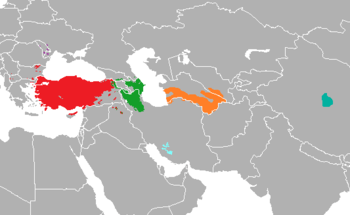
Azerbaijani is one of the Oghuz languages within the Turkic language family. Ethnologue classifies North Azerbaijani (spoken mainly in the Republic of Azerbaijan and Russia) and South Azerbaijani (spoken in Iran, Iraq, and Syria) as separate languages with "significant differences in phonology, lexicon, morphology, syntax, and loanwords."[2]
Svante Cornell wrote in his 2001 book Small Nations and Great Powers that "it is certain that Russian and Iranian words (sic), respectively, have entered the vocabulary on either side of the Araxes river, but this has not occurred to an extent that it could pose difficulties for communication.".[39] There are numerous dialects, with 21 North Azerbaijani dialects and 11 South Azerbaijani dialects identified by Ethnologue.[2][3]
Four varieties have been accorded ISO 639-3 language codes: North Azerbaijani, South Azerbaijani, Salchuq, and Qashqai. The Glottolog 4.1 database classifies North Azerbaijani, with 20 dialects, and South Azerbaijani, with 13 dialects, under the Modern Azeric family, a branch of Central Oghuz.[4]
According to the Linguasphere Observatory, all Oghuz languages form part of a single "outer language" of which North and South Azerbaijani are "inner languages".
North Azerbaijani

North Azerbaijani,[2] or Northern Azerbaijani, is the official language of the Republic of Azerbaijan. It is closely related to the modern-day Istanbul Turkish, the official language of Turkey. It is also spoken in southern Dagestan, along the Caspian coast in the southern Caucasus Mountains and in scattered regions throughout Central Asia. As of 2011, there are some 9.23 million speakers of North Azerbaijani including 4 million monolingual speakers (many North Azerbaijani speakers also speak Russian, as is common throughout former USSR countries).[2]
The Shirvan dialect as spoken in Baku is the basis of standard Azerbaijani. Since 1992, it has been officially written with a Latin script in the Republic of Azerbaijan, but the older Cyrillic script was still widely used in the late 1990s.[40]
Ethnologue lists 21 North Azerbaijani dialects: Quba, Derbend, Baku, Shamakhi, Salyan, Lenkaran, Qazakh, Airym, Borcala, Terekeme, Qyzylbash, Nukha, Zaqatala (Mugaly), Qabala, Yerevan, Nakhchivan, Ordubad, Ganja, Shusha (Karabakh), Karapapak.[2]
South Azerbaijani
South Azerbaijani,[3] is widely spoken in Iranian Azerbaijan and, to a lesser extent, in neighboring regions of Turkey and Iraq, with smaller communities in Syria. In Iran, the Persian word for Azerbaijani is borrowed as Torki "Turkic".[3] In Iran, it is spoken mainly in East Azerbaijan, West Azerbaijan, Ardabil and Zanjan. It is also widely spoken in Tehran and across Tehran Province, as Azerbaijanis form by far the largest minority in the city and the wider province,[41] comprising about 1/3,[42][43] of its total population. The CIA World Factbook reports in 2010 the percentage of Iranian Azerbaijani speakers at around 16 percent of the Iranian population, or approximately 13 million people worldwide,[44] and ethnic Azeris form by far the second largest ethnic group of Iran, thus making the language also the second most spoken language in the nation.[45] Ethnologue reports 10.9 million Iranian Azerbaijani in Iran in 2016 and 13,823,350 worldwide.[3] Dialects of South Azerbaijani include: Aynallu (Inallu, Inanlu), Qarapapaq, Tabrizi, Qashqai, Afshari (Afsar, Afshar), Shahsavani (Shahseven), Muqaddam, Baharlu (Kamesh), Nafar, Qaragözlü, Pishaqchi, Bayatlu, Qajar, Marandli.[3]
Azerbaijani vs. Turkish
Historically, Azerbaijani and Turkish speakers have been able to communicate with relative ease. One example of this is when Reza Shah Pahlavi of Iran (who spoke Azerbaijani) met with Mustafa Kemal Atatürk of Turkey (who spoke Turkish) in 1934.[46][47][48][49][50][51] Speakers of Turkish and Azerbaijani can, to an extent, communicate with each other as both languages have substantial variation and are to a degree mutually intelligible. Azerbaijani exhibits a similar stress pattern to Turkish but simpler in some respects. Azerbaijani is a strongly stressed and partially stress-timed language, unlike Turkish which is weakly stressed and syllable-timed.
Here are some words with a different pronunciation in Azerbaijani and Turkish that mean the same in both languages:
| Azerbaijani | Turkish | English |
|---|---|---|
| ayaqqabı | ayakkabı | shoes |
| ayaq | ayak | foot |
| kitab | kitap | book |
| qardaş | kardeş | brother |
| qan | kan | blood |
| qaz | kaz | goose |
| qaş | kaş | eyebrow |
| qar | kar | snow |
| daş | taş | stone |
Phonology
Phonotactics
Azerbaijani phonotactics is similar to other Oghuz Turkic languages, except:
- Trimoraic syllables with long vowels are permissible.
- There is an ongoing metathesis of neighboring consonants in a word.[52] Speakers tend to reorder consonants in the order of decreasing sonorancy and back-to-front (for example, iləri becomes irəli, köprü becomes körpü, topraq becomes torpaq). Some of the metatheses are so common in the educated speech that they are reflected in orthography (all the above examples are like that). This phenomenon is more common in rural dialects, but observed even in educated young urban speakers.
- Intramorpheme /q/ becomes /x/.
Consonants
| Labial | Dental | Alveolar | Palato- alveolar |
Palatal | Velar | Glottal | ||||||||
|---|---|---|---|---|---|---|---|---|---|---|---|---|---|---|
| Nasal | m | n | ||||||||||||
| Stop | p | b | t | d | t͡ʃ | d͡ʒ | c | (ɟ) | (k) | ɡ | ||||
| Fricative | f | v | s | z | ʃ | ʒ | x | ɣ | h | |||||
| Approximant | l | j | ||||||||||||
| Flap | ɾ | |||||||||||||
- as in Turkish, in native words the velar consonant /ɡ/ is palatalized to [ɟ] when adjacent to the front vowels, but unlike Turkish, Azerbaijani at different periods have been written using Arabic, Roman and Cyrillic letters and in each case the two allophones of /ɡ/ had their own letter.[53] ق, q, г for [ɡ] and گ, g, ҝ for [ɟ].
- The sound [k] is used only in loanwords; the historical unpalatalized [k] became voiced to [ɡ].
- /t͡ʃ/ and /d͡ʒ/ are realised as [t͡s] and [d͡z] respectively in the areas around Tabriz and to the west, south and southwest of Tabriz (including Kirkuk in Iraq); in the Nakhchivan and Ayrum dialects, in Cəbrayil and some Caspian coastal dialects;[54]
- In most dialects of Azerbaijani, /c/ is realized as [ç] when it is found in the syllabic coda or is preceded by a voiceless consonant (as in çörək [t͡ʃøˈɾæç] – "bread"; səksən [sæçˈsæn] – "eighty").
- /w/ exists in the Kirkuk dialect as an allophone of /v/ in Arabic loanwords.
- In the Baku subdialect, /ov/ may be realised as [oʊ], and /ev/ and /øv/ as [øy], e.g. /ɡovurˈmɑ/ → [ɡoʊrˈmɑ], /sevˈdɑ/ → [søyˈdɑ], /døvˈrɑn/ → [døyˈrɑn], as well as with surnames ending in -ov or -ev (borrowed from Russian).[55]
- In colloquial speech, /x/ is usually pronounced as [χ]
Dialect consonants
- Dz dz—[d͡z]
- Ć ć—[t͡s]
- Ŋ ŋ—[ŋ]
- Q̇ q̇—[ɢ]
- Ð ð—[ð]
- W w—[w/ɥ]
Examples:
- [d͡z]—dzan [d͡zɑn̪]
- [t͡s]—ćay [t͡sɑj]
- [ŋ]—ataŋın [ʔɑt̪ɑŋən̪]
- [ɢ]—q̇ar [ɢɑɾ]
- [ð]—əðəli [ʔæðæl̪ɪ]
- [w]—dowşan [d̪ɔːwʃɑn̪]
- [ɥ]—töwlə [t̪œːɥl̪æ]
Vowels
The vowels of the Azerbaijani are, in alphabetical order,[56][57] a /ɑ/, e /e/, ə /æ/, ı /ɯ/, i /i/, o /o/, ö /ø/, u /u/, ü /y/. There are no diphthongs in standard Azerbaijani when two vowels come together; when that occurs in some Arabic loanwords, diphthong is removed by either syllable separation at V.V boundary or fixing the pair as VC/CV pair, depending on the word.
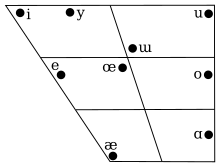
| Front | Back | |||
|---|---|---|---|---|
| Unrounded | Rounded | Unrounded | Rounded | |
| Close | i | y | ɯ | u |
| Mid | e | ø | o | |
| Open | æ | ɑ | ||
The typical phonetic quality of South Azerbaijani vowels is as follows:
- /i, u, æ/ are close to cardinal [i, u, a].[58]
- The F1 and F2 formant frequencies overlap for /œ/ and /ɯ/. Their acoustic quality is more or less close-mid central [ɵ, ɘ]. The main role in the distinction of two vowels is played by the different F3 frequencies in audition[59] and rounding in articulation. Phonologically, however, they are more distinct: /œ/ is phonologically a mid front rounded vowel, the front counterpart of /o/ and the rounded counterpart of /e/. /ɯ/ is phonologically a close back unrounded vowel, the back counterpart of /i/ and the unrounded counterpart of /u/.
- The other mid vowels /e, o/ are closer to close-mid [e, o] than open-mid [ɛ, ɔ].[58]
- /ɑ/ is phonetically near-open back [ɑ̝].[58]
Writing systems
Before 1929, Azerbaijani was written only in the Perso-Arabic alphabet. In 1929–1938 a Latin alphabet was in use for North Azerbaijani (although it was different from the one used now), from 1938 to 1991 the Cyrillic script was used, and in 1991 the current Latin alphabet was introduced, although the transition to it has been rather slow.[60] For instance, until an Aliyev decree on the matter in 2001,[61] newspapers would routinely write headlines in the Latin script, leaving the stories in Cyrillic;[62] the transition also resulted in some misrendering of İ as Ì.[63][64]
In Iran, Azerbaijani is still written in the Persian alphabet, and in Dagestan, in Cyrillic script.
The Perso-Arabic Azerbaijani alphabet is an abjad; that is, it does not represent vowels. Also, some consonants can be represented by more than one letter. The Azerbaijani Latin alphabet is based on the Turkish Latin alphabet, which in turn was based on former Azerbaijani Latin alphabet because of their linguistic connections and mutual intelligibility. The letters Әə, Xx, and Qq are available only in Azerbaijani for sounds which do not exist as separate phonemes in Turkish.
| Old Latin (1929-1938 version; no longer in use; replaced by 1991 version) |
Official Latin (Azerbaijan since 1991) |
Cyrillic (1958 version, still official in Dagestan) |
Perso-Arabic (Iran; Azerbaijan until 1929) |
IPA |
|---|---|---|---|---|
| A a | А а | آ / ـا | /ɑ/ | |
| B в | B b | Б б | ﺏ | /b/ |
| Ç ç | C c | Ҹ ҹ | ﺝ | /dʒ/ |
| C c | Ç ç | Ч ч | چ | /tʃ/ |
| D d | Д д | ﺩ | /d/ | |
| E e | Е е | ئ | /e/ | |
| Ə ə | Ә ә | ا / َ / ە | /æ/ | |
| F f | Ф ф | ﻑ | /f/ | |
| G g | Ҝ ҝ | گ | /ɟ/ | |
| Ƣ ƣ | Ğ ğ | Ғ ғ | ﻍ | /ɣ/ |
| H h | Һ һ | ﺡ / ﻩ | /h/ | |
| X x | Х х | خ | /x/ | |
| Ь ь | I ı | Ы ы | یٛ | /ɯ/ |
| I i | İ i | И и | ی | /i/ |
| Ƶ ƶ | J j | Ж ж | ژ | /ʒ/ |
| K k | К к | ک | /c/, /k/ | |
| Q q | Г г | ﻕ | /ɡ/ | |
| L l | Л л | ﻝ | /l/ | |
| M m | М м | ﻡ | /m/ | |
| N n | Н н | ﻥ | /n/ | |
| Ꞑ ꞑ[65] | Ng ng | Нҝ нҝ | ݣ / نگ | /ŋ/ |
| O o | О о | وْ | /o/ | |
| Ө ө | Ö ö | Ө ө | ؤ | /ø/ |
| P p | П п | پ | /p/ | |
| R r | Р р | ﺭ | /r/ | |
| S s | С с | ﺙ / ﺱ / ﺹ | /s/ | |
| Ş ş | Ш ш | ﺵ | /ʃ/ | |
| T t | Т т | ﺕ / ﻁ | /t/ | |
| U u | У у | ۇ | /u/ | |
| Y y | Ü ü | Ү ү | ۆ | /y/ |
| V v | В в | ﻭ | /v/ | |
| J j | Y y | Ј ј | ی | /j/ |
| Z z | З з | ﺫ / ﺯ / ﺽ / ﻅ | /z/ | |
| - | ʼ | ع | /ʔ/ | |
Northern Azerbaijani, unlike Turkish, respells foreign names to conform with Latin Azerbaijani spelling, e.g. Bush is spelled Buş and Schröder becomes Şröder. Hyphenation across lines directly corresponds to spoken syllables as in other Turkic languages.
Vocabulary
Interjections
Some samples include:
Secular:
- Of ("Ugh!")
- Tez Ol ("Be quick!")
- Tez olun qızlar mədrəsəyə ("Be quick girls, to school!", a slogan for an education campaign in Azerbaijan)
Invoking deity:
- implicitly:
- Aman ("Mercy")
- Çox şükür ("Much thanks")
- explicitly:
- Allah Allah (pronounced as Allahallah) ("Goodness gracious")
- Hay Allah; Vallah "By God [I swear it]".
- Çox şükür allahım ("Much thanks my god")
Formal and informal
Azerbaijani has informal and formal ways of saying things. This is because there is a strong tu-vous distinction in Turkic languages like Azerbaijani and Turkish (as well as in many other languages). The informal "you" is used when talking to close friends, relatives, animals or children. The formal "you" is used when talking to someone who is older than you or someone for whom you would like to show respect (a professor, for example).
As in many Turkic languages, personal pronouns can be omitted, and they are only added for emphasis. Azerbaijani has a phonetic writing system, so pronunciation is easy: most words are pronounced exactly as they are spelled in the modern Azerbaijani alphabet.
| Category | English | North Azerbaijani (in Latin script) |
|---|---|---|
| Basic expressions | yes | hə /hæ/ (informal), bəli (formal) |
| no | yox /jox/ (informal), xeyr (formal) | |
| hello | salam /sɑlɑm/ | |
| goodbye | sağ ol /ˈsɑɣ ol/ | |
| sağ olun /ˈsɑɣ olun/ (formal) | ||
| good morning | sabahınız xeyır /sɑbɑhɯ(nɯ)z xejiɾ/ | |
| good afternoon | günortanız xeyır /ɟynoɾt(ɯn)ɯz xejiɾ/ | |
| good evening | axşamın xeyır /ɑxʃɑmɯn xejiɾ/ | |
| axşamınız xeyır /ɑxʃɑmɯ(nɯ)z xejiɾ/ | ||
| Colours | black | qara /ɡɑɾɑ/ |
| blue | mavi /mâvi/ | |
| brown | qəhvəyi / qonur | |
| grey | boz /boz/ | |
| green | yaşıl /jaʃɯl/ | |
| orange | narıncı /nɑɾɯnd͡ʒɯ/ | |
| pink | çəhrayı | |
| purple | bənövşəyi | |
| red | qırmızı /ɡɯɾmɯzɯ/ | |
| white | ağ /ɑɣ/ | |
| yellow | sarı /sɑɾɯ/ |
Numbers
| Number | Word |
|---|---|
| 0 | sıfır /ˈsɯfɯɾ/ |
| 1 | bir /biɾ/ |
| 2 | iki /ici/ |
| 3 | üç /yt͡ʃ/ |
| 4 | dörd /døɾd/ |
| 5 | beş /beʃ/ |
| 6 | altı /ɑltɯ/ |
| 7 | yeddi /jed:i/ |
| 8 | səkkiz /sækciz/ |
| 9 | doqquz /doɡ:uz/ |
| 10 | on /on/ |
For numbers 11–19, the numbers literally mean "10 one, 10 two" and so on.
| Number | Word |
|---|---|
| 20 | iyirmi /ijiɾmi/ [lower-alpha 1] |
| 30 | otuz /otuz/ |
| 40 | qırx /ɡɯɾx/ |
| 50 | əlli /ælli/ |
Greater numbers are constructed by combining in tens and thousands larger to smaller in the same way, without using a conjunction in between.
Notes
- Former Cyrillic spelling used in the Azerbaijan Soviet Socialist Republic.
- /iɾmi/ is also found in standard speech.
References
- Azerbaijani at Ethnologue (21st ed., 2018)
North Azerbaijani at Ethnologue (21st ed., 2018)
South Azerbaijani at Ethnologue (21st ed., 2018)
Salchuq at Ethnologue (21st ed., 2018)
Qashqai at Ethnologue (21st ed., 2018) - "Azerbaijani, North". Ethnologue. Archived from the original on 5 June 2019. Retrieved 2 February 2020.
- "Azerbaijani, South". Ethnologue. Archived from the original on 5 June 2019. Retrieved 2 February 2020.
- Hammarström, Harald; Forkel, Robert; Haspelmath, Martin, eds. (2019). "Modern Azeric". Glottolog 4.1. doi:10.5281/zenodo.3554959. Retrieved 5 February 2020.
- Hammarström, Harald; Forkel, Robert; Haspelmath, Martin, eds. (2019). "North Azerbaijani". Glottolog 4.1. doi:10.5281/zenodo.3554959. Retrieved 5 February 2020.
- Hammarström, Harald; Forkel, Robert; Haspelmath, Martin, eds. (2019). "South Azerbaijani". Glottolog 4.1. doi:10.5281/zenodo.3554959. Retrieved 5 February 2020.
- Christiane Bulut. "Syntactic Traces of Turkic-Iranian Contiguity". In: Johanson, Lars and Bulut, Christiane (eds.). Turkic-Iranian Contact Areas. Otto Harrassowitz Verlag, 2006.
- Djavadi, Abbas (19 July 2010). "Iran's Ethnic Azeris and the Language Question". RadioFreeEurope/RadioLiberty. Retrieved 24 January 2016.
- electricpulp.com. "AZERBAIJAN viii. Azeri Turkish – Encyclopaedia Iranica". www.iranicaonline.org. Retrieved 24 January 2016.
- Brown, Keith, ed. (24 November 2005). Encyclopedia of Language and Linguistics. Elsevier. pp. 634–638. ISBN 9780080547848.
Native speakers of Azerbaijani reside, in addition to the Republic of Azerbaijan (where North Azerbaijani is spoken), in Iran (South Azerbaijani), Dagestan, Georgia, Turkey, Syria and Iraq. North Azerbaijani is marked by Russian loanwords and South Azerbaijani is distinguished by Persian loanwords.
- Sinor, Denis (1969). Inner Asia. History-Civilization-Languages. A syllabus. Bloomington. pp. 71–96. ISBN 0-87750-081-9.
- Mudrak, Oleg (30 April 2009). "Language in time. Classification of Turkic languages (in Russian)". polit.ru. Retrieved 31 August 2019.
The collapse of the Turkmen-Azerbaijani. Despite all the assurances that Azerbaijani is the closest relative of Turkish, this is not so. The closest relative of it (Azerbaijani) is Turkmen. The collapse of this unity falls on around 1180. It is amazing. Because it matches with the period of collapse of the Great Seljuk Empire. This state, which included lands south of the Amu Darya: Afghanistan, Iran, the territory of modern Iraq, including Baghdad, Northern Syria, etc., was disintegrating. Then, the Khwarazmshahs appeared, but direct contacts between the population that was “ east of the Caspian Sea " and the population that was in the region of Tabriz, the heart of Azerbaijan and the Great Seljuk Empire, ceased.
- "Türk dili, yoxsa azərbaycan dili? (Turkish language or Azerbaijani language?)". BBC (in Azerbaijani). 9 August 2016. Retrieved 15 August 2016.
- Atabaki, Touraj (2000). Azerbaijan: Ethnicity and the Struggle for Power in Iran. I.B.Tauris. p. 25. ISBN 9781860645549.
- Dekmejian, R. Hrair; Simonian, Hovann H. (2003). Troubled Waters: The Geopolitics of the Caspian Region. I.B. Tauris. p. 60. ISBN 978-1860649226.
Until 1918, when the Musavat regime decided to name the newly independent state Azerbaijan, this designation had been used exclusively to identify the Iranian province of Azerbaijan.
- Rezvani, Babak (2014). Ethno-territorial conflict and coexistence in the caucasus, Central Asia and Fereydan: academisch proefschrift. Amsterdam: Amsterdam University Press. p. 356. ISBN 978-9048519286.
The region to the north of the river Araxes was not called Azerbaijan prior to 1918, unlike the region in northwestern Iran that has been called since so long ago.
- "AZERBAIJAN". Encyclopaedia Iranica, Vol. III, Fasc. 2-3. 1987. pp. 205–257.CS1 maint: ref=harv (link)
- This is an illustrated copy of Hadikat al-Su'ada of Fuzuli who in his own words wrote it under the grace of an Ottoman official during the reign of the Ottoman sultan, Suleyman the Magnificent (1520-1566) in or before 1547. The text in Azeri Turkish concerns the hardships endured by Prophet Muhammad and his family, especially his grandsons' death in Karbala, Iraq where the author Fuzuli was from. The manuscript is copied in 19 lines of naskh on 167 folios. There are notes and description of miniatures in Turkish in a later hand.
- "The Turkic Languages", Osman Fikri Sertkaya (2005) in Turks – A Journey of a Thousand Years, 600-1600, London ISBN 978-1-90397-356-1
- Wright, Sue; Kelly, Helen (1998). Ethnicity in Eastern Europe: Questions of Migration, Language Rights and Education. Multilingual Matters Ltd. p. 49. ISBN 978-1-85359-243-0.
- Bratt Paulston, Christina; Peckham, Donald (1 October 1998). Linguistic Minorities in Central and Eastern Europe. Multilingual Matters Ltd. pp. 98–115. ISBN 978-1-85359-416-8.
- L. Johanson, "AZERBAIJAN ix. Iranian Elements in Azeri Turkish" in Encyclopædia Iranica .
- John R. Perry, "Lexical Areas and Semantic Fields of Arabic" in Csató et al. (2005) Linguistic convergence and areal diffusion: case studies from Iranian, Semitic and Turkic, Routledge, p. 97: "It is generally understood that the bulk of the Arabic vocabulary in the central, contiguous Iranic, Turkic and Indic languages was originally borrowed into literary Persian between the ninth and thirteenth centuries CE ..."
- electricpulp.com. "AZERBAIJAN ix. Iranian Elements in Azeri Turki – Encyclopaedia Iranica".
- "Alphabet Changes in Azerbaijan in the 20th Century". Azerbaijan International. Spring 2000. Retrieved 21 July 2013.
- Language Commission Suggested to Be Established in National Assembly. Day.az. 25 January 2011.
- Johanson, L. (6 April 2010). Brown, Keith; Ogilvie, Sarah (eds.). Concise Encyclopedia of Languages of the World. Elsevier. pp. 110–113. ISBN 978-0-08-087775-4 – via Google Books.
- Öztopcu, Kurtulus. "Azeri / Azerbaijani". American Association of Teachers of Turkic Languages. Retrieved 5 February 2020.
- G. Doerfer, "Azeri Turkish", Encyclopaedia Iranica, viii, Online Edition, p. 246.
- Mark R.V. Southern. Mark R V Southern (2005) Contagious couplings: transmission of expressives in Yiddish echo phrases, Praeger, Westport, Conn. ISBN 978-0-31306-844-7
- "Greetings to Heydar Baba". umich.edu. Retrieved 8 September 2010.
- Pieter Muysken, "Introduction: Conceptual and methodological issues in areal linguistics", in Pieter Muysken (2008) From Linguistic Areas to Areal Linguistics, p. 30-31 ISBN 90-272-3100-1
- Viacheslav A. Chirikba, "The problem of the Caucasian Sprachbund" in Muysken, p. 74
- Lenore A. Grenoble (2003) Language Policy in the Soviet Union, p. 131 ISBN 1-4020-1298-5
- Nikolai Trubetzkoy (2000) Nasledie Chingiskhana, p. 478 Agraf, Moscow ISBN 978-5-77840-082-5 (Russian)
- J. N. Postgate (2007) Languages of Iraq, p. 164, British School of Archaeology in Iraq ISBN 0-903472-21-X
- Homa Katouzian (2003) Iranian history and politics, Routledge, pg 128: "Indeed, since the formation of the Ghaznavids state in the tenth century until the fall of Qajars at the beginning of the twentieth century, most parts of the Iranian cultural regions were ruled by Turkic-speaking dynasties most of the time. At the same time, the official language was Persian, the court literature was in Persian, and most of the chancellors, ministers, and mandarins were Persian speakers of the highest learning and ability"
- "Date of the Official Instruction of Oriental Languages in Russia" by N.I.Veselovsky. 1880. in W.W. Grigorieff ed. (1880) Proceedings of the Third Session of the International Congress of Orientalists, Saint Petersburg (Russian)
- A study of Study of Ethnopolitical Conflict in the Caucasus, author Svante E.Cornell, 2001, page 22 (ISBN 0-203-98887-6)
- Schönig (1998), pg. 248.
- "Azeris". World Directory of Minorities and Indigenous People. Retrieved 5 July 2013.
- "Iran-Azeris". Library of Congress Country Studies. December 1987. Retrieved 13 August 2013.
- International Business Publications (2005). Iran: Country Study Guide. International Business Publications. ISBN 978-0-7397-1476-8.CS1 maint: ref=harv (link)
- "The World Factbook". Cia.gov. Retrieved 13 July 2013.
- Shaffer, Brenda (2006). The Limits of Culture: Islam and Foreign Policy. MIT Press. ISBN 978-0-262-19529-4.CS1 maint: ref=harv (link), p. 229
- Yelda, Rami (2012). A Persian Odyssey: Iran Revisited. AuthorHouse. ISBN 978-1-4772-0291-3.CS1 maint: ref=harv (link), p. 33
- "Reza Shah - Historic Footage with Soundtrack".
- IranLiveNews (31 October 2010). "The only known footage of the Reza Shah of Iran with audio discovered in Turkey" – via YouTube.
- felixiran (23 September 2007). "Reza Shah of Iran speaks to Kemal Ataturk" – via YouTube.
- felixiran (8 September 2007). "Reza Shah of Iran meets Ataturk of Turkey" – via YouTube.
- Mafinezam, Alidad; Mehrabi, Aria (2008). Iran and Its Place Among Nations. Greenwood Publishing Group. ISBN 978-0-275-99926-1.CS1 maint: ref=harv (link), p. 57
- Kök, Ali (1 December 2016). "Modern Oğuz Türkçesi Diyalektlerinde Göçüşme". 21. Yüzyılda Eğitim Ve Toplum Eğitim Bilimleri Ve Sosyal Araştırmalar Dergisi (in Turkish). 5 (15): 406–430. ISSN 2147-0928.
- Heselwood, Barry (2013). Phonetic Transcription in Theory and Practice. EDINGBURGH University Press. p. 8.
- Persian Studies in North America by Mohammad Ali Jazayeri
- Shiraliyev, Mammadagha. The Baku Dialect. Azerbaijan SSR Academy of Sciences Publ.: Baku, 1957; p. 41
- Householder and Lotfi. Basic Course in Azerbaijani. 1965.
- Shiralyeva (1971)
- Mokari & Werner (2016), p. 509.
- Mokari & Werner (2016), p. 514.
- Dooley, Ian (6 October 2017). "New Nation, New Alphabet: Azerbaijani Children's Books in the 1990s". Cotsen Children's Library (in English and Azerbaijani). Princeton University WordPress Service. Retrieved 13 December 2017.
Through the 1990s and early 2000s Cyrillic script was still in use for newspapers, shops, and restaurants. Only in 2001 did then president Heydar Aliyev declare "a mandatory shift from the Cyrillic to the Latin alphabet" ... The transition has progressed slowly.
- Peuch, Jean-Christophe (1 August 2001). "Azerbaijan: Cyrillic Alphabet Replaced By Latin One". Radio Free Europe / Radio Liberty. Retrieved 13 December 2017.
- Monakhov, Yola (31 July 2001). "Azerbaijan Changes Its Alphabet". Getty Images. Retrieved 13 December 2017.
- Dilənçi, Piruz (translator); Khomeini, Ruhollah (15 March 1997). "Ayətulla Homeynì: "... Məscìd ìlə mədrəsədən zar oldum"". Müxalifət (in Azerbaijani and Persian). Baku. Retrieved 13 December 2017.
- Yahya, Harun. "Global Impact of the Works of Harun Yahya V2". Secret Beyond Matter. Retrieved 23 April 2020.
- Excluded from the alphabet in 1938
Bibliography
- Mokari, Payam Ghaffarvand; Werner, Stefan (2016), Dziubalska-Kolaczyk, Katarzyna (ed.), "An acoustic description of spectral and temporal characteristics of Azerbaijani vowels", Poznań Studies in Contemporary Linguistics, 52 (3), doi:10.1515/psicl-2016-0019
External links
| Azerbaijani edition of Wikipedia, the free encyclopedia |
| South Azerbaijani edition of Wikipedia, the free encyclopedia |
| Wikivoyage has a phrasebook for Azerbaijani. |
| Azerbaijani language test of Wikinews at Wikimedia Incubator |
| Wikimedia Commons has media related to Azerbaijani language. |
- A blog on Azerbaijani language resources and translations
- (in Russian) A blog about the Azerbaijani language and lessons
- azeri.org, Azerbaijani literature and English translations.
- Online bidirectional Azerbaijani-English Dictionary
- Learn Azerbaijani at learn101.org.
- Pre-Islamic roots
- Azerbaijan-Turkish language in Iran by Ahmad Kasravi.
- including sound file.
- Azerbaijani<>Turkish dictionary (Pamukkale University)
- Azerbaijan Language with Audio
- Azerbaijani thematic vocabulary
- AzConvert, an open source Azerbaijani transliteration program.
- Azerbaijani Alphabet and Language in Transition, the entire issue of Azerbaijan International, Spring 2000 (8.1) at azer.com.
